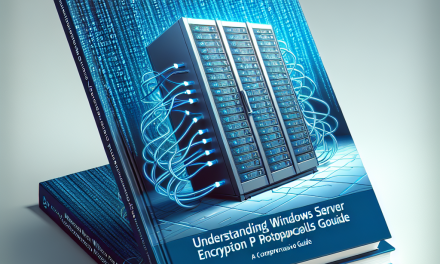In today’s digital landscape, where cyber threats are becoming increasingly sophisticated, securing your Windows Server environment should be a top priority. One of the most effective strategies to safeguard your organization’s IT infrastructure is to employ a multi-layer protection approach. In this article for WafaTech Blogs, we will explore how to implement multi-layer security in Windows Server environments, ensuring your systems remain resilient against various types of attacks.
Understanding Multi-Layer Security
Multi-layer security, also known as defense-in-depth, involves deploying multiple security measures across different layers within your IT environment. This approach minimizes the risk of a single point of failure and provides comprehensive protection against a variety of threats. In a Windows Server context, multi-layer protection typically encompasses the following layers:
- Network Security
- Endpoint Security
- Application Security
- Data Security
- User Access Control
- Monitoring and Incident Response
Let’s break down each of these layers and explore best practices for implementing them in your Windows Server environment.
1. Network Security
Network security is the first line of defense against external threats. Key strategies for enhancing network security in Windows Server environments include:
- Firewalls: Configure Windows Defender Firewall or other third-party firewalls to restrict inbound and outbound traffic based on your organization’s security policies.
- Network Segmentation: Divide your network into segments to limit access and reduce the impact of a breach. Use VLANs and subnetting to create isolated environments for sensitive data and critical applications.
- Virtual Private Networks (VPNs): Implement VPNs to secure remote access for employees, ensuring encrypted communications over public networks.
2. Endpoint Security
Endpoints, such as servers and client machines, can be vulnerable to various attacks. To protect these assets:
- Antivirus and Anti-Malware Software: Ensure that all endpoints have updated antivirus and anti-malware solutions installed. Solutions like Microsoft Defender for Endpoint can provide robust protection against threats.
- Device Encryption: Utilize BitLocker Drive Encryption to protect sensitive data on Windows Server machines by encrypting the hard drives.
- Patch Management: Regularly update your Windows Server operating systems and applications to protect against known vulnerabilities. Automating the patch management process can alleviate the burden on IT teams.
3. Application Security
Applications running on Windows Server are often targeted for exploitation. Strengthen application security through:
- Secure Configuration: Follow best practices for securing Windows applications and services by disabling unnecessary features and services.
- Web Application Firewalls (WAF): Deploy WAF solutions to protect web applications from common exploits such as SQL injection and cross-site scripting (XSS).
- Regular Security Audits: Conduct periodic security assessments and penetration testing to identify potential vulnerabilities within applications.
4. Data Security
Data is one of your most valuable assets, so it must be adequately protected:
- Data Classification: Classify data based on sensitivity to determine the appropriate level of protection required.
- Access Control Lists (ACLs): Implement strict ACLs on file systems to limit access to sensitive data only to authorized users.
- Backup Solutions: Regularly back up data using Windows Server Backup or third-party solutions. Ensure backups are encrypted and securely stored.
5. User Access Control
Restricting access to sensitive resources is crucial for preventing unauthorized exploitation:
- Least Privilege Principle: Grant users the minimum level of access necessary to perform their jobs. Regularly review and adjust permissions as needed.
- Multi-Factor Authentication (MFA): Implement MFA for accessing critical systems and applications to add an extra layer of security.
- User Activity Monitoring: Keep track of user activities and access logs to detect any suspicious behavior early on.
6. Monitoring and Incident Response
Finally, continuously monitor your environment and have a solid incident response plan in place:
- Security Information and Event Management (SIEM): Utilize SIEM tools to collect and analyze security event logs from various sources within your infrastructure.
- Intrusion Detection Systems (IDS): Deploy IDS solutions to identify and alert on potential security breaches in real-time.
- Incident Response Planning: Develop and regularly update an incident response plan detailing the steps to be taken in the event of a security breach.
Conclusion
In a landscape filled with evolving cyber threats, implementing a multi-layer protection strategy in your Windows Server environment is not just advisable; it’s essential. By building a robust security posture through network security, endpoint protection, application security, data security, user access control, and vigilant monitoring, you can significantly reduce the risk of breaches and ensure the integrity, availability, and confidentiality of your IT assets.
For further insights and best practices, keep following WafaTech Blogs as we regularly share updates and tips to help you strengthen your security strategy and thrive in the digital age. Investing in multi-layered security is investing in the safety and resilience of your organization.





